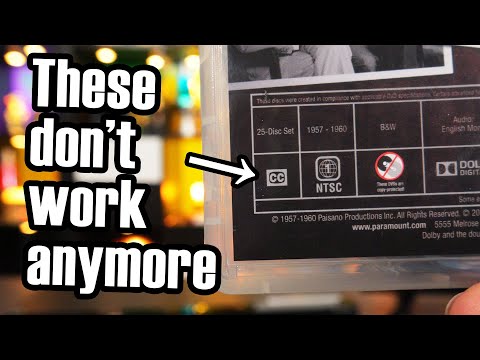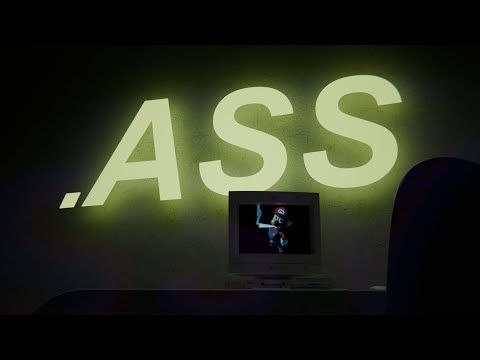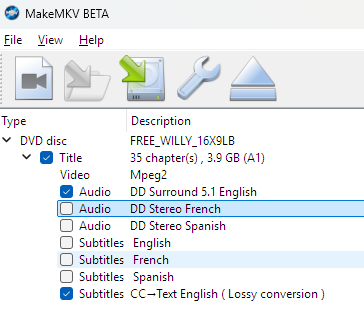New video time!
A whole lot of folks keep forgetting about closed captions on DVDs, and as time has marched on this means they're getting less accessible.

New video time!
A whole lot of folks keep forgetting about closed captions on DVDs, and as time has marched on this means they're getting less accessible.

@TechConnectify
Gods I remember how cool all the little special features on DVDs used to be. Blueray too. It is so strange how far we've allowed our media to degrade.
Now we have to fight tooth and nail just for basic closed captions... :<
@kasperd @3dcandy @TechConnectify you can always buy from charity / thrift shops though.
I'm not getting rid of our vast collection any time soon as im sick of streaming sites ads creeping in, tge ads getting longer and having to pay extra on top of your monthly subscriptions.
@TechConnectify I learned things!
Things that I have zero use for.
But then again, I know how DOS interrupts work.
@TechConnectify thank you for that video. And OMG, all this time I had assumed that HDMI actually provisioned some kind of auxiliary data channel for a counterpart to the line 21 data. But a quick glance over the standard, and… it does in fact not. What the heck?
Goes to show, that I'm not a very active consumer of "television" and alike content.

@TechConnectify And this is where everyone outside the US is discovering that closed caption isn't just a US linguistic term for what we call subtitles in the rest of the world...
Great video, as always.
@TechConnectify You sent me down this rabbit hole too. I've written several MPEG2-TS decoders in my career, and when I was watching this video, I assumed they'd used another PID in the TS stream on the DVD. Turns out it is stored in the video stream. And not in line 21. There is additional data in the MPEG2 elementary video stream that has the EIA-608 data in it. To prove this, I got an old DVD, decrypted the VOBs, used ffmpeg to extract ONLY the video stream, and then passed that to ccextractor to see if it could find captions, and it worked!
I also tried MakeMKV (A popular archiving tool) to see what it thinks. Even though you can see in the screenshot it recognizes the CC stream separate from the subtitles, it strips them from the MPEG2 ES stream it puts into the mkv file (proved by extracting the m2v from the mkv, passing that to ccextractor, which finds no closed captioning)
@TechConnectify I tried to run MakeMKV with the following settings, and the resulting MKV file plays in VLC with a subtitle track! So, there is hope for MakeMKV for DVDs that ONLY have EIA-608 closed captions. In the bit of research I did about MakeMKV, it seems like it's using ccextractor under the hood to convert these to SRT.
Try MakeMKV on your Perry Mason DVDs and see how the subtitles look.
SRT does not support text positioning, so the positioning of EIA-608 CC is lost in this conversion.
Having tested the same Perry Mason DVD's with MakeMKV (I coincidentally ripped them for someone last month) I don't see any text transcription errors but the missing positioning is definitely a bit of a downgrade.
@TechConnectify I wonder if there’s a different handling on this depending on the region - I’m in Brazil and pretty much all content here (local or foreign) includes subtitles - didn’t check CCs, will take a look at this later.
Also: I’m currently working on archiving our home DVD collection to our NAS - approx. 200 titles, cloning the discs using Brasero on my Linux laptop - then I’ll replace Plex with Jellyfin to be able to watch them via streaming.
@TechConnectify The current episode of @radiolab is a fun accidental companion piece to your video.

@TechConnectify
Thanks for giving attention to often ignored accessibility features! Love to see it.
What are the episodes and timestamps where VLC had issues for you?
After seeing @rcombs comment on YouTube I got motivated to try replicating your issue to report it to the VLC devs. I have copies of the same DVDs available but don't see the same rendering problems in VLC in Linux or Windows, although in Windows I do see it using the same worse looking fallback font as shown in the video.
@TechConnectify interesting
My experience with DVB-SUB is that VLC sucks at that too. Even teletext rendering, which to be fair it does support, it doesn’t do all that well…
As for preservation, it is absolutely possible to put CTA-708 (which can wrap CTA-608) into an H.264 NAL unit in a similar way to how it can be embedded in MPEG-2 but I have no clue if people are doing this!
The good news is that guess is that I still work with CTA-608/708 quite a bit when writing software for broadcasters so… the knowledge is at least still out there
(Yes, EIA-608 got renamed to CTA-608 a while ago - it’s a bit of a rabbit hole!)
@TechConnectify I can confirm that WinDVD supports captions.
I don't know how correct they are though as all my DVD players are computers
It has an option to not show the black background and seems to be moving them around the screen
@TechConnectify Looking forward to watching this one. I still buy DVDs, and I make them into MKV files with captions included, so it's of interest to me (especially when I need subtitles, e.g. non-English films).
One irritating thing is that VLC (which I use on my Android TV) keeps glitching the video stream whenever it has a new caption to display.
I hate smart TVs. I'm now looking to get a dumb display and build my own media server to feed it!
@TechConnectify I see that VLC has a few open issues on CC rendering, and I wonder how many of those derive from having a lot of devs in region 2 or, well, anything that is not region 1?
@TechConnectify I've been embarked on the "scanning all my disks before The Rot gets them" train for a while and have had to get very creative with extracting, OCR'ing, and reassembling bluray rips to make their subtitles compatible with home media servers to the point of writing software just to make it work.
Media companies have made preserving subs on physical collections very difficult for the sake of inconveniencing pirates (who often just dump them rather than dealing with it)
@TechConnectify with those older shows, is it that the DVD has those subtitles encoded somewhere deliberately, or is it that they are encoded into the overscan area of the old video as part of the transfer process, i.e. the DVD was mastered from a video tape source?
In which case the diff could be that the composite signal has the whole frame, while HDMI sends the cropped full frames and doesn't have any overscan handling?
